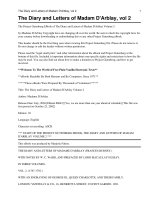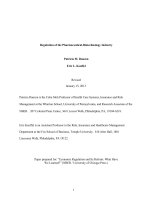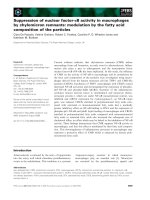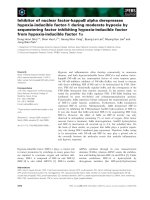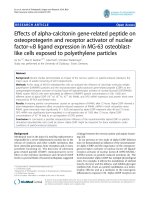The regulation of nuclear factor erythroid derived 2 related factor 2 (NRF2) in the phase 2 response 2
Bạn đang xem bản rút gọn của tài liệu. Xem và tải ngay bản đầy đủ của tài liệu tại đây (24.15 MB, 119 trang )
THE REGULATION OF NUCLEAR FACTOR
ERYTHROID-2 (NF-E2)-RELATED FACTOR 2
(NRF2) IN THE PHASE 2 RESPONSE
DAPHNE WONG PEI WEN
B.Sc. (Hons), NUS
A THESIS SUBMITTED FOR THE DEGREE OF
DOCTOR OF PHILOSOPHY
DEPARTMENT OF BIOCHEMISTRY
NATIONAL UNIVERSITY OF SINGAPORE
2014
!
!
ii!
Acknowledgements
I am grateful to A/P Thilo Hagen, my supervisor, for the
opportunity to conduct my research in his lab. My work would not have
been possible without his guidance and patience. Thank you for
patiently teaching me and being so understanding and helpful.
I would like to thank Christine Hu Zhi-Wen for her emotional
support and encouragement; as well as Chua Yee Liu, Hong Shin Yee,
Michelle Fong, Dr. Tan Chia Yee, Regina Wong Wan Ju and Jessica
Leck Yee Chin for making my lab experience an enjoyable one. I am
grateful to Dr. Boh Boon Kim and Dr. Choo Yin Yin for providing the
Keap1 plasmids. I am also grateful to the endophyte team: Tan Shi
Hua, Lim Shu Ying, Lim Ee Chien, Seah Wen Hui, Christine Hu, Ng Mei
Ying and Daphne Ng Hui Ping for their contribution in the endophyte
project. I would also like to thank all other members of the lab, past and
present, for their help and support.
Last but not least, I am deeply grateful to my husband Moses
Tan, my parents and my sister for their love and encouragement
throughout the duration of my PhD.
!
!
iii!
DECLARATION
I hereby declare that the thesis is my original work and it has been
written by me in its entirety. I have duly acknowledged all the sources
of information which have been used in the thesis.
This thesis has also not been submitted for any degree in any
university previously.
Daphne Wong Pei Wen
21 August 2014
!
!
iv!
Table of Contents
Acknowledgements ii
Declaration iii
Summary vii
List of Tables ix
List of Figures x
List of Abbreviations xii
1.0 Introduction 1
1.1 Oxidative stress and its implications 1
1.1.1 The role of oxidative stress in carcinogenesis 1
1.2 Nrf2 (Nuclear factor erythroid-2 (NF-E2)-related factor 2) 4
1.3 The antioxidant response mechanism by Nrf2 4
1.4 Nrf2 Knockout Mouse Models 8
1.5 Regulation of Nrf2 activity 9
1.5.1 Post-translational modification of Nrf2 9
1.5.2 Degradation of Nrf2 : Keap1 and Cullin3 E3 Ubiquitin Ligase 9
1.5.3 Accumulation of Nrf2 : Keap1 as a sensor for electrophilic and
oxidative stress 13
1.6 The role of Nrf2 inducers in cancer chemoprevention 16
2.0 Materials and Methods 18
2.1 Cell culture 18
2.2 DNA Transfection 18
!
!
v!
2.3 Plasmid constructs 19
2.4 Chemicals and inducers 19
2.5 Immunoblotting 20
2.6 Luciferase reporter assay 20
2.7 Immunoprecipitation 21
2.8 Immunoflourescence 21
2.9 Collection and processing of plants 22
2.10 Growth and isolation of endophytes 22
2.11 Molecular identification of isolated endophytes 23
2.12 Organic extraction of secondary metabolites from endophytes 23
3.0 The Induction of Phase 2 response by Heteroaromatic Quinols 26
3.1 Introduction 26
3.2 Results 29
3.2.1 Heteroaromatic quinols increase Nrf2 protein concentrations 29
3.2.2 Heteroaromatic quinols increase Nrf2 transcriptional activation 32
3.2.3 Effect of quinol analogues on Nrf2 transcriptional activation
when Nrf2 ubiquitination is prevented 35
3.2.4 PMX290 markedly increases the interaction of Keap1 with
Cullin3 39
3.2.5 PMX290 increases Keap1 autoubiquitination 42
3.2.6 Effect of PMX290 on Keap1-dependent nuclear shuttling of Nrf2 44
3.2.7 Effect of PMX290 is independent of cysteine 151 in Keap1 48
3.3 Summary 52
4.0 Activation of Nrf2 by Andrographolide 54
4.1 Introduction 54
4.2 Results 56
!
!
vi!
4.2.1 Andrographolide induces the accumulation of Nrf2 in a
Keap1 cysteine 151-dependent manner 56
!!!!! 4.2.2 Andrographolide increases Nrf2 transcriptional activation 58
4.2.3 Effect of andrographolide on Keap1-Cullin3 interaction 60
4.2.4 Correlation between the dependency of Nrf2 inducers on
cysteine 151 of Keap1 and their effect on the Keap1-
Cullin3 interaction 61
4.2.5 Proposed model through which Keap1 Cys151-independent
Nrf2 inducer compounds inhibit Nrf2 ubiquitination 63
4.3 Summary 67
5.0 Investigating novel Nrf2 inducer compounds in endophytes 69
5.1 Introduction 69
5.2 Results 72
5.2.1 Isolation and identification of bacterial and fungal endophytes
from tropical ferns and mosses 72
5.2.2 Investigating the effect of organic extracts isolated from
the endophytes on Nrf2 transcriptional activation 81
5.2.3 Investigating the effect of organic extracts isolated
from the endophytes on Nrf2 protein concentration 85
5.3 Summary 87
6.0 Discussion and Conclusion 89
7.0 References 95
!
!
!
!
vii!
Summary
The detrimental effects of oxidative stress have been linked to
major diseases such as cancer and neurodegenerative diseases.
Oxidative stress can be sensed by the Keap1-Nrf2 system in the cell,
which triggers cytoprotection via the phase 2 response. Nrf2, a
transcription factor, binds to the antioxidant response element (ARE) to
induce the expression of phase 2 detoxifying and antioxidant enzymes.
Nrf2 is regulated at the protein level by Keap1, a substrate receptor for
the Cullin3 E3 ubiquitin ligase. Binding of Keap1 to Nrf2 facilitates the
Cullin3-mediated ubiquitination and subsequent degradation of Nrf2.
We have identified a class of heteroaromatic quinol compounds
as novel Nrf2 inducers. We also characterized the activation of Nrf2 by
the diterpenoid andrographolide. The quinol compounds as well as
andrographolide were shown to increase the Nrf2 protein concentration
and Nrf2 dependent transcription. Nrf2 inducers are expected to
covalently modify critical cysteine residues in Keap1, resulting in the
inhibition of the Keap1-mediated Nrf2 ubiquitination and degradation.
Our results show that andrographolide exerts its effect by targeting
cysteine 151 in the BTB domain of Keap1. On the other hand, the
quinol compounds function independently of cysteine 151 in Keap1.
Interestingly, the quinol compounds markedly increased the binding
between Keap1 and Cullin3 whereas andrographolide did not. Given
these observations and reports on the mechanism of other Nrf2
!
!
viii!
inducers, we suggest a correlation where Cys151-independent Nrf2
inducers cause an increase in the Keap1-Cullin3 interaction whereas
Cys151-dependent Nrf2 inducers promote the dissociation of Keap1
from Cullin3. Thus, we propose that Cys151-independent Nrf2 inducers
function via a novel mechanism that is distinct from Cys151-dependent
Nrf2 inducers. The elucidation of the mechanism of action of Cys151-
independent Nrf2 inducers is expected to improve our understanding of
the regulation of the Keap1-Cullin3 E3 ubiquitin ligase.
Since secondary bioactive metabolites isolated from endophytes
are a useful source of novel bioactive compounds in drug discovery, we
also aimed to discover and investigate novel Nrf2 inducers from
endophytes. Here, we demonstrated the presence of a potential novel
Nrf2 inducer in the organic extract of a fungal endophyte, Phomopsis
sp The understanding of novel Nrf2 inducers would provide useful
insights for the development of therapeutics against oxidative stress-
related diseases.
!
!
ix!
List of Tables
Table 1. List of target genes of Nrf2 based on chromatin
immunoprecipitation (ChIP) analysis.
Table 2. Correlation between the dependency of Nrf2 inducers on
cysteine 151 of Keap1 with Keap1-Cullin3 interaction.
Table 3. List of isolated fungal and bacterial endophytes.
!
!
x!
List of Figures
Figure 1.1
Schematic representation of the domains
and conserved regions in Keap1 and Nrf2.
pg 12
Figure 1.2
Schematic representation of the binding of
Keap1 to Nrf2 which targets Nrf2 for
ubiquitination.
pg 13
Figure 3.1
Chemical structures of PMX464, PMX290
and BW114.
pg 27
Figure 3.2
Chemical reaction between PMX464 and a
reactive cysteine.
pg 28
Figure 3.3
Western blot analyses of the effect of the
quinol compounds on Nrf2 protein.
pg 31
Figure 3.4
Quinol compounds increase Nrf2
transcriptional activation.
pg 34
Figure 3.5
Effect of quinol compounds when Nrf2
ubiquitination is inhibited by dnUbc12.
pg 36
Figure 3.6
PMX290 may have an inhibitory effect on
Nrf2 transcriptional activity.
pg 38
Figure 3.7
Effect of the quinol compounds on binding
of Keap1 to Nrf2, Cullin3 and Keap1
homodimerization in vivo.
pg 41
Figure 3.8
Effect of PMX290 and sulforaphane on
Keap1 ubiquitination in vivo.
pg 44
Figure 3.9
Effect of PMX290 on Keap1-dependent
nuclear shuttling of Nrf2.
pg 47
Figure 3.10
Effect of PMX290 on ΔDGR Keap1-Cullin3
interaction in vivo.
pg 49
Figure 3.11
Effect of PMX290 on Nrf2 protein
concentration and Keap1-Cullin3
interaction when Cys151 of Keap1 is
mutated.
pg 51
!
!
xi!
Figure 4.1
Chemical structure of Andrographolide.
pg 55
Figure 4.2
Western blot analysis of Nrf2 protein
concentrations in HEK293T cells after
treatment with andrographolide.
pg 57
Figure 4.3
Andrographolide increases Nrf2
transcriptional activation.
pg 59
Figure 4.4
Effect of andrographolide on Keap1-Cullin3
interaction in vivo.
pg 60
Figure 4.5
Proposed model through which Cys151-
independent Nrf2 inducer compounds
inhibit Nrf2 ubiquitination.
pg 66
Figure 5.1
Schematic representation of ITS regions
and ribosomal rDNA of fungus.
pg 73
Figure 5.2
Screening of 49 organic extracts isolated
from the endophytes for Nrf2
transcriptional activation.
pg 82
Figure 5.3
Effect of potential organic extracts on Nrf2
transcriptional activity.
pg 83
Figure 5.4
Dose response of organic extracts on Nrf2
transcriptional activation.
pg 84
Figure 5.5
Western blot analysis of the effect of
organic extracts isolated from the
endophytes on Nrf2 protein concentration.
pg 86
!
!
xii!
List of Abbreviations
ARE antioxidant response element
BTB Broad complex, Tramtrack, and Bric-a-Brac
bZIP basic leucine zipper
CBP CREB-binding protein
CnC Cap’n’Collar
Cul3 Cullin3
dnUbc12 dominant negative ubiquitin-conjugating enzyme 12
ER endoplasmic reticulum
HO-1 heme oxygenase 1
ITS internal transcribed spacer
IVR intervening region
Keap1 Kelch-like ECH-associated protein 1
MAPK Mitogen-activated protein kinases
NF-E2 Nuclear factor erythroid-2
NF- κB Nuclear Factor- kappaB
Nrf2 Nuclear factor erythroid-2 (NF-E2)-related factor 2
Nqo1 NAD(P)H:quinine oxidoreductase 1
!
!
xiii!
PKC Protein Kinase C
Rbx RING-box protein 1
SF sulforaphane
tBHQ tert-butyl hydroxyquinone
Ub ubiquitin
!
!
!
1!
1.0 Introduction
1.1 Oxidative stress and its implications
Maintaining redox homeostasis is important for normal cellular
function. Pathology occurs when cellular redox homoestasis is
disrupted - when reactive species are in excess of antioxidants.
Reactive species causes oxidative damage to biomolecules such as
nucleic acids, proteins and lipids resulting in cellular membrane
damage, DNA mutations and apoptotic cell death (Sies, 1997). The
accumulated oxidative damage is believed to be the cause of a range
of health problems such as cancer, neurodegenerative diseases,
chronic inflammation and metabolic disorders.
1.1.1 The role of oxidative stress in carcinogenesis
Many studies have suggested that chronic oxidative stress is
associated with cancer initiation and carcinogenesis. For example,
oxidative stress contributes to the development of chronic gastritis, a
condition that frequently progresses to gastric cancer (Konturek et al.,
2006). Similarly, oxidative stress is involved in the pathogenesis of
ulcerative colitis, which is known to be strongly associated with
colorectal cancer (Seril et al., 2003).
Induction of oxidative stress and oxidative damage has been
observed in cells exposed to pro-oxidants and electrophilic reactive
!
!
2!
species such as heavy metals, xenobiotics and carcinogens (Sykiotis
and Bohmann, 2010). For example, radiation, barbiturates, chlorinated
compounds, metal ions, phorbol esters and various other xenobiotics
have been shown to induce oxidative stress and oxidative damage in
vitro and in vivo (Klaunig et al., 1998). Exposure to these oxidative
stress inducers have been demonstrated to cause cancer initiation and
carcinogenesis in several studies. For example, arsenic was shown to
disturb redox homeostasis and induce oxidative DNA damage in Swiss
albino mice (Sinha et al., 2010; Sinha and Roy, 2011) and chronic
exposure to arsenic can lead to skin, lung, bladder, liver and prostate
cancer (Kim et al., 2011). Besides that, acrylonitrile, which induces
primary brain tumours in rats, has also been shown to induce oxidative
stress in rat brain tissue (Bigner et al., 1986; Johannsen and
Levinskas, 2002).
In cells undergoing prolonged oxidative stress, oxidative
damage to nucleic acids, proteins and lipids could result in errors in
protein synthesis and function as well as gene expression. This could
lead to the dysregulation of oncoproteins and tumor suppressor
proteins. In particular, oxidative damage has been associated with
aflatoxin B-induced mutations in the p53 and ras genes in
hepatocarcinogenesis (Shen and Ong, 1996).
Through various signalling pathways, cells have developed the
ability to sense oxidants and electrophiles and induce antioxidant
defense mechanisms to protect the cells against oxidative stress
!
!
3!
(Sykiotis and Bohmann, 2010). The activation of antioxidant defense
mechanisms include the upregulation of the expression of genes
involved in the detoxification of xenobiotics and carcinogens,
maintainence of redox balance and cytoprotection. Therefore, drug-
induced activation of these pathways could be a good strategy for
cancer chemoprevention. The most prominent antioxidant signalling
pathway that is activated by electrophiles and oxidative stress is the
Nrf2 pathway.
!
!
4!
1.2 Nrf2 (Nuclear factor erythroid-2 (NF-E2)-related factor 2)
Nrf2 belongs to the Cap'n'Collar basic leucine zipper (CnC-bZip)
transcription factor family (Moi et al., 1994). This is due to the presence
of a conserved 43-amino acid Cap’n’Collar (CnC) domain at the N-
terminus of the Nrf2 DNA binding domain (Figure 1.1). The name
‘Nuclear factor erythroid-2 (NF-E2)-related factor 2’ is derived from
another transcription factor p45 NFE2 (nuclear factor erythroid-derived
2) from the same CnC-bZip family.
Nrf2 contains a Basic Leucine Zipper Domain (bZIP domain)
which mediates sequence specific DNA binding. The leucine zipper is
required to hold together two DNA binding regions (dimerization). Nrf2
dimerizes with a member of the small Maf (musculoaponeurotic
fibrosarcoma oncogene) family (Katsuoka et al., 2005; Itoh et al.,
1997; Motohashi et al., 2004). The Nrf2-Maf dimer binds to the
antioxidant response element (ARE) sequences to drive transcription of
antioxidant enzymes and detoxifying proteins. The ARE consensus
sequence for Nrf2 binding has been identified to be
TMAnnRTGAYnnnGCR (where (M = A or C, R = A or G, Y = C or T)
(Wasserman and Fahl, 1997).
1.3 The antioxidant response mechanism by Nrf2
!
!
5!
Early evidences suggesting the role of Nrf2 in the antioxidant
response mechanism originated from studies showing the upregulation
of NAD(P)H:quinine oxidoreductase 1 (NQO1) (an enzyme involved in
maintaining redox balance in the cell) by Nrf2, in response to oxidative
stress from xenobiotics and electrophiles (Venugopal and Jaiswal,
1996). In this study, overexpression of Nrf2 in cell lines was shown to
induce the expression of the NQO1 gene when subjected to
xenobiotics-induced oxidative stress.
During high levels of oxidative stress, Nrf2 accumulates in the
cell and binds to the antioxidant response elements (ARE) in the
promoter of phase 2 genes to trigger the transcriptional activation of
cytoprotective drug metabolizing and antioxidant genes (Itoh et al.,
1997). This adaptive response to oxidative stress has been termed
‘phase 2 detoxification and antioxidant response’. The activation of Nrf2
upregulates the transcription of phase 2 genes including thioredoxins
and glutathione-synthesizing enzymes (to maintain redox balance),
drug-metabolising enzymes such as glutathione S-transferases, drug-
efflux pumps and other cytoprotective proteins (Table 1) (Itoh et al.,
1997; Sykiotis and Bohmann, 2010).
!
!
6!
Target Genes
Symbol
Function
Glutamate-cysteine ligase, catalytic
subunit
GCLC
Synthesis and
conjugation of
glutathione
Glutamate-cysteine ligase, modifier
subunit
GCLM
Glutathione reductase
GSR
Glutathione S-transferase alpha 4
GSTA4
Glutathione S-transferase mu 2
GSTM2
Glutathione S-transferase mu 3
GSTM3
Microsomal glutathione S-transferase 2
MGST2
Peroxiredoxin 1
PRDX1
Antioxidant
Sulfiredoxin 1
SRXN1
Thioredoxin
TXN
Thioredoxin reductase 1
TXNRD1
NAD(P)H dehydrogenase, quinone 1
NQO1
Drug metabolizing
enzymes and
transporters
Epoxide hydrolase 1, microsomal
(xenobiotic)
EPHX1
Aldehyde oxidase 1
AOX1
ATP-binding cassette, subfamily B
(MDR/TAP), member 6
ABCB6
ATP-binding cassette, subfamily C
(CFTR/MRP), member 1
ABCC1
ATP-binding cassette, subfamily C
(CFTR/MRP), member 5
ABCC5
Solute carrier family 25 (mitochondrial
carrier; phosphate carrier), member 25
SLC25A25
Solute carrier family 44, member 3
SLC44A3
Solute carrier family 48 (heme
transporter), member 1
SLC48A1
Solute carrier family 7 (anionic amino
acid transporter light chain, xc-system),
member 11
SLC7A11
Transketolase
TKT
Metabolic enzymes
Glucose-6-phosphate dehydrogenase
G6PD
!
!
7!
Isocitrate dehydrogenase 1 (NADP
+
),
soluble
IDH1
2-Aminoethanethiol (cysteamine)
dioxygenase
ADO
Lipoprotein lipase
LPL
Heme oxygenase (decycling) 1
HMOX1
Heme and iron
metabolism
Biliverdin reductase B [flavin reductase
(NADPH)]
BLVRB
Ferrochelatase
FECH
Ferritin, heavy polypeptide 1
FTH1
Ferritin, light polypeptide
FTL
Aryl hydrocarbon receptor
AHR
Transcription factors
CCAAT/enhancer binding protein
(C/EBP), alpha
CEBPA
Hairy and enhancer of split 1
HES1
v-maf musculoaponeurotic
fibrosarcoma oncogene homolog G
(avian)
MAFG
v-myc myelocytomatosis viral oncogene
homolog (avian)
MYC
Retinoid X receptor, alpha
RXRA
YY1 associated factor 2
YAF2
Table 1. List of target genes of Nrf2 based on chromatin
immunoprecipitation (ChIP) analysis.
Adapted from Suzuki et al., 2013. ChIP analysis data from Malhotra et
al., 2010; Chorley et al., 2012; and Hirotsu et al., 2012.
!
!
8!
1.4 Nrf2 Knockout Mouse Models
Since Nrf2 plays an important role in antioxidant response
mechanism for cytoprotection and oxidative stress adaptation, various
studies has been carried out to investigate the effect of Nrf2 knockout
in mice. Even though Nrf2 knockout mice were viable and fertile, they
were extremely sensitive to oxidative and ER stress (Chan et al.,
1996; Hubbs et al., 2007; Ma et al., 2006). Nrf2 knockout mice were
shown to be more susceptible to neurodegeneration and carcinogen-
induced cancers.
Nrf2 knockout mice were observed to be more susceptible to
dextran sulphate sodium (DSS)-induced colitis and azoxymethane-
induced-colorectal carcinogenesis (Khor et al., 2006; Khor et al., 2008).
Besides colorectal cancer, Nrf2 deficient mice had a higher incidence
rate of liver tumours when exposed to the carcinogenic 2-amino-3-
methylimidazo quinoline (Kitamura et al., 2007). Nrf2 deficient mice that
were challenged with benzo-[a]pyrene were also found to have higher
burdens of gastric neoplasias compared to wild type mice (Ramos-
Gomez et al., 2001).
Since the Nrf2 deficient mice are unable to elicit a defence
against carcinogen-induced oxidative stress, it can be concluded that
Nrf2 plays a significant role in protecting the cells against oxidative
stress-induced cancer initiation. Hence, it is important to study the
regulation of Nrf2 activity.
!
!
9!
1.5 Regulation of Nrf2 activity
1.5.1 Post-translational modification of Nrf2
Protein function and activity is most commonly regulated via
post-translation modifications such as phosphorylation and acetylation.
The transcriptional coactivator p300/CBP has been reported to
acetylate Nrf2 at several lysine residues (Lys438, Lys443, Lys445,
Lys462, Lys472, Lys506, Lys507, Lys518, Lys543, Lys548, Lys554
and Lys555) (Sun, Chin & Zhang, 2009). Acetylation of Nrf2 was
reported to promote binding of Nrf2 to specific ARE promoters. Besides
that, Nrf2 can also be phosphorylated by PKC, Fyn and MAPKs (Bloom
and Jaiswal, 2003; Huang et al., 2002). However, the phosphorylation
of Nrf2 has been shown to have either positive or negative effects on
its function (Sun, Huang & Zhang, 2009).
Although these studies indicate that Nrf2 can be post-
translationally modified, its activity is known to be primarily regulated
via its protein levels (abundance) in the cell.
1.5.2 Degradation of Nrf2 : Keap1 and Cullin3 E3 Ubiquitin Ligase
Nrf2 activity is normally kept at low levels by its cytoplasmic
inhibitor Keap1 (Kelch-like ECH-associating protein 1) (Itoh et al.,
1999). Because Keap1 is tethered to the actin cytoskeleton, it can
suppress Nrf2 activity by sequestering Nrf2 in the cytoplasm thus
!
!
10!
preventing it from translocating into the nucleus to bind to ARE to
induce the phase 2 genes.
Besides that, Keap1 was also shown to be a substrate receptor
of a Cullin-3-based E3 ubiquitin ligase. Under normal conditions, Keap1
functions to anchor Nrf2 and target it for ubiquitination and
consequently 26S proteasome-mediated degradation (Figure 1.2)
(Zhang et al., 2004). Keap1 associates with Cullin3 and Rbx1 to form a
functional E3 ubiquitin ligase complex that targets Nrf2 for
ubiquitination. The Cullin3 E3 ubiquitin complex, via the associated
RING domain containing protein Rbx1, recruits a ubiquitin charged E2
ubiqutin-conjugating enzyme, thus facilitating the transfer of ubiquitin to
lysine residues (Lys 44, Lys 50, Lys 52, Lys 53, Lys 56, Lys 64, Lys 68)
in the substrate Nrf2 (Figure 1.1 and Figure 1.2).
Keap1 consists of three functional domains: BTB (Broad
complex, Tramtrack, and Bric-a-Brac), IVR (intervening region) and the
Kelch repeat (Figure 1.1) (Bardwell and Treisman, 1994; McMahon et
al., 2006). The BTB domain mediates homodimerization of Keap1 as
well as binding of Keap 1 to Cullin3. In addition, it has been suggested
that the IVR of Keap1 also plays an important role in the binding to
Cullin3 (Kobayashi et al., 2004). The Kelch repeat domain of Keap1
protein binds to two specific domains in Nrf2, the ETGE motif and the
DLG motif located in the Neh2 conserved domain to target Nrf2 for
ubiquitination and proteasome-mediated degradation (Figure 1.1 and
Figure 1.2) (Tong, Katoh, et al., 2006; McMahon et al., 2006). Because
!
!
11!
only one Keap1 protein can bind to only one of the ETGE or DLG
motifs, Keap1 binds Nrf2 as a dimer.
Keap1 interacts with these two conserved motifs with different
affinities. The high affinity binding of Keap1 to the ETGE motif serves
as a ‘hinge’ to pin down the Neh2 domain of Nrf2 to Keap1 (Tong,
Kobayashi, et al., 2006; Li and Kong, 2009). On the other hand, Keap1
binds to the DLG domain with lower affinity and this interaction serves
as a ‘latch’. It is likely that the high affinity interaction of Keap1 with the
ETGE motif is a prerequisite for the subsequent low affinity interaction
between Keap1 and the DLG site. The positioning of the ‘latch’ may
promote the correct orientation of the lysine residues on Nrf2 for
ubiquitin binding. This ‘hinge & latch’ model (Tong, Kobayashi, et al.,
2006) is a two-site binding model of Keap1 to Nrf2 and should be
distinguished from a one-site ‘hinge’ binding model. The one-site
binding is a mere binding between Keap1 and the ETGE motif due to
its higher affinity and does not present Nrf2 in the correct orientation for
ubiquitination. It has been shown that the deletion of the low affinity
DLG domain, which is involved in the ‘latch’ binding in Nrf2, prevented
Nrf2 degradation (McMahon et al., 2004). Therefore, only the two-sites
‘hinge & latch’ binding model would allow Nrf2 to be ubiquitinated.
In summary, since Nrf2 is highly unstable under normal
conditions, Nrf2 activity is mainly regulated via regulation of its stability.
Keap1 plays a significant role in the regulation of Nrf2 protein levels by
binding to Nrf2 and targeting it to the Cullin-3-based E3 ubiquitin ligase
!
!
12!
complex for ubiquitination. The poly-ubiquitination and subsequent
degradation of Nrf2 keeps Nrf2 protein levels low in the absence of
oxidative stress and this represses its ability to induce phase 2 genes.
Figure 1.1 Schematic representation of the domains and
conserved regions in Keap1 and Nrf2. (a) The conserved regions on
Nrf2: The Neh2 domain has two important motifs, DLG motif (amino
acids 29-31) and the ETGE motif (amino acids 79-82) which are
involved in the binding of Keap1. There are seven lysine residues
between the DLG motif and the ETGE motif which can be ubiquitinated.
(b) Three functional domains in Keap1: BTB domain, IVR (intervening
region) and Kelch repeat domain.
Adapted from McMahon et al., 2006.
Nrf2%
BTB
IVR
Kelch repeat domain
Keap1%
a%
b%
!!!Neh2
KKKKKKK!
Transactivation Domain
CnC
bZIP
DLG!!!!!!!!!!!!ETGE!
Cys151! !!!!!!!!!!!!!Cys273!Cys288!
